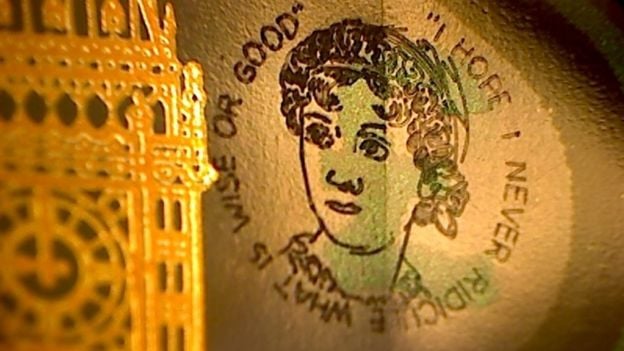
If you’re in UK these days, you might want to keep a close eye on your change: Micro-engraver Graham Short, known for his almost impossibly-tiny works of art, has engraved five £5 notes with a minuscule portrait of Jane Austen.
After increasing their value to an estimated £50,000 ($62,000)—Short claims similar of his drawings have been insured for that amount—the 70-year-old artist and his gallery, Tony Huggins-Haig Gallery of Kelso, Scotland, surreptitiously spent four of them in England, Wales, Scotland, and Northern Ireland. A fifth bill was donated by the artist to the Jane Austen Society.
The idea was inspired by Willie Wonka’s Golden Tickets, hidden inside chocolate bars in the Roald Dahl children’s book Charlie and the Chocolate Factory. To date, no one has come forward with one of the special Austen bills.
One baker is already regretting the lost opportunity. Alan Malone of Granny Jean’s Home Bakery in Kelso, Scotland, had no idea that when gallerist Tony Huggins-Haig stopped in on Monday, December 5, he was using currency with added value. Huggins-Haig called to confess what happened two days later, but the bill was in the wind, having been given out as change that same day.
The serial numbers of Graham Short’s Jane Austen micro-engravings. Courtesy of Graham Short.
“I’m absolutely gutted that I didn’t know. I would have kept it,” Malone told the Daily Mail. “I’ve just moved house and could have done with the money. I would have had a very good Christmas.” He expects the left the shop between about 10:30 a.m. and 1:30 p.m., when they ran out of fivers.
Though the valuable work of art slipped through Malone’s fingers, there has been a silver lining: “The whole thing has been a great advert for the shop as we’ve never been busier,” he admitted.
To create his tiny masterpieces, Short used the UK’s new polymer banknotes, which were first issued in September. The new bills are manufactured using transparent plastic film, and will be more durable, as well as more difficult to counterfeit.
“I’m always looking to do something different and as soon as I saw the new £5 note I thought ‘wouldn’t it be good if I could engrave something on it?'” said Short to the Mirror. “The beauty of this is that you can’t see the engraving at all, but when you turn the note and the light comes at a different angle it appears. I call it invisible engraving.”
The new Jane Austen note. Courtesy of the Bank of England.
Short’s engravings, on the translucent area next to Big Ben, are just five millimeters tall, and are difficult to see with the naked eye. You won’t need to examine all your change with a microscope however, as they’ve kindly released the serial numbers, each starting with “AM32 885,” of the Austen bills.
Each drawing took over two weeks to complete, and is accompanied by a different quote from Austen’s books Emma, Pride and Prejudice, and Mansfield Park.
To create his minute works, Short reportedly uses a stethoscope, working only between heartbeats to keep still, and gets Botox to keep the nerves around his eyes from twitching. For Short’s last project, he engraved the Queen’s portrait on a speck of gold inside the eye of a needle. It sold for £100,000 ($125,000).
There may only be four Austen bills currently in circulation, but that is soon to change. In 2013, the British government announced plans to release a new £10 note featuring the beloved author for 2017, which marks the 200th anniversary of Austen’s death.